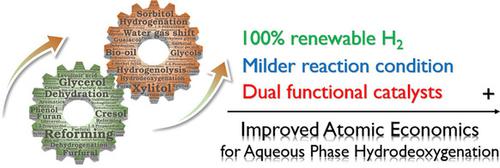当前位置:
X-MOL 学术
›
ChemSusChem
›
论文详情
Our official English website, www.x-mol.net, welcomes your
feedback! (Note: you will need to create a separate account there.)
Catalytic Transfer Hydrogenation of Biomass‐Derived Substrates to Value‐Added Chemicals on Dual‐Function Catalysts: Opportunities and Challenges
ChemSusChem ( IF 7.5 ) Pub Date : 2018-12-10 , DOI: 10.1002/cssc.201801620 Xin Jin 1 , Bin Yin 1 , Qi Xia 1 , Tianqi Fang 1 , Jian Shen 2 , Liquan Kuang 3 , Chaohe Yang 1
ChemSusChem ( IF 7.5 ) Pub Date : 2018-12-10 , DOI: 10.1002/cssc.201801620 Xin Jin 1 , Bin Yin 1 , Qi Xia 1 , Tianqi Fang 1 , Jian Shen 2 , Liquan Kuang 3 , Chaohe Yang 1
Affiliation

|
Aqueous‐phase hydrodeoxygenation (APH) of bioderived feedstocks into useful chemical building blocks is one the most important processes for biomass conversion. However, several technological challenges, such as elevated reaction temperature (220–280 °C), high H2 pressure (4–10 MPa), uncontrollable side reactions, and intensive capital investment, have resulted in a bottleneck for the further development of existing APH processes. Catalytic transfer hydrogenation (CTH) under much milder conditions with non‐fossil‐based H2 has attracted extensive interest as a result of several advantageous features, including high atom efficiency (≈100 %), low energy intensity, and green H2 obtained from renewable sources. Typically, CTH can be categorized as internal H2 transfer (sacrificing small amounts of feedstocks for H2 generation) and external H2 transfer from H2 donors (e.g., alcohols, formic acid). Although the last decade has witnessed a few successful applications of conventional APH technologies, CTH is still relatively new for biomass conversion. Very limited attempts have been made in both academia and industry. Understanding the fundamentals for precise control of catalyst structures is key for tunable dual functionality to combine simultaneous H2 generation and hydrogenation. Therefore, this Review focuses on the rational design of dual‐functionalized catalysts for synchronous H2 generation and hydrogenation of bio‐feedstocks into value‐added chemicals through CTH technologies. Most recent studies, published from 2015 to 2018, on the transformation of selected model compounds, including glycerol, xylitol, sorbitol, levulinic acid, hydroxymethylfurfural, furfural, cresol, phenol, and guaiacol, are critically reviewed herein. The relationship between the nanostructures of heterogeneous catalysts and the catalytic activity and selectivity for C−O, C−H, C−C, and O−H bond cleavage are discussed to provide insights into future designs for the atom‐economical conversion of biomass into fuels and chemicals.
中文翻译:

生物质底物催化转移加氢成双功能催化剂上的增值化学品:机遇与挑战
生物衍生原料的水相加氢脱氧(APH)成为有用的化学结构单元是生物质转化的最重要过程之一。但是,一些技术挑战,例如升高的反应温度(220–280°C),高的H 2压力(4–10 MPa),不可控制的副反应以及大量的资本投资,导致了现有技术的进一步发展的瓶颈。 APH流程。由于具有许多优点,包括高原子效率(≈100%),低能量强度和从中获得的绿色H 2,具有非化石基H 2的较温和条件下的催化转移氢化(CTH)引起了广泛的关注。可再生资源。通常,CTH可以归类为内部H2转移(牺牲少量原料用于H 2生成)和H 2供体(例如,醇,甲酸)的外部H 2转移。尽管过去十年见证了传统APH技术的一些成功应用,但CTH在生物质转化方面仍相对较新。在学术界和工业界都进行了非常有限的尝试。理解精确控制催化剂结构的基本原理是可调谐双重功能将H 2的生成与氢化相结合的关键。因此,本综述着重于同步H 2的双功能催化剂的合理设计。通过CTH技术将生物原料生产和氢化为增值化学品。本文严格审查了2015年至2018年发表的有关选定模型化合物转化的最新研究,这些模型化合物包括甘油,木糖醇,山梨糖醇,乙酰丙酸,羟甲基糠醛,糠醛,甲酚,苯酚和愈创木酚。讨论了非均相催化剂的纳米结构与C-O,CH,C-C和O-H键裂解的催化活性和选择性之间的关系,以为生物质的原子经济转化为未来的设计提供见解燃料和化学品。
更新日期:2018-12-10
中文翻译:

生物质底物催化转移加氢成双功能催化剂上的增值化学品:机遇与挑战
生物衍生原料的水相加氢脱氧(APH)成为有用的化学结构单元是生物质转化的最重要过程之一。但是,一些技术挑战,例如升高的反应温度(220–280°C),高的H 2压力(4–10 MPa),不可控制的副反应以及大量的资本投资,导致了现有技术的进一步发展的瓶颈。 APH流程。由于具有许多优点,包括高原子效率(≈100%),低能量强度和从中获得的绿色H 2,具有非化石基H 2的较温和条件下的催化转移氢化(CTH)引起了广泛的关注。可再生资源。通常,CTH可以归类为内部H2转移(牺牲少量原料用于H 2生成)和H 2供体(例如,醇,甲酸)的外部H 2转移。尽管过去十年见证了传统APH技术的一些成功应用,但CTH在生物质转化方面仍相对较新。在学术界和工业界都进行了非常有限的尝试。理解精确控制催化剂结构的基本原理是可调谐双重功能将H 2的生成与氢化相结合的关键。因此,本综述着重于同步H 2的双功能催化剂的合理设计。通过CTH技术将生物原料生产和氢化为增值化学品。本文严格审查了2015年至2018年发表的有关选定模型化合物转化的最新研究,这些模型化合物包括甘油,木糖醇,山梨糖醇,乙酰丙酸,羟甲基糠醛,糠醛,甲酚,苯酚和愈创木酚。讨论了非均相催化剂的纳米结构与C-O,CH,C-C和O-H键裂解的催化活性和选择性之间的关系,以为生物质的原子经济转化为未来的设计提供见解燃料和化学品。











































 京公网安备 11010802027423号
京公网安备 11010802027423号